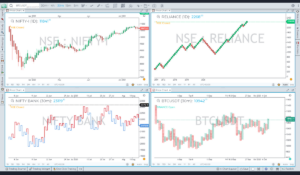
In the field of technical analysis, Renko charts stand out as a distinctive and significant tool that gives traders a novel perspective on price changes. In this blog, we go deeply into the world of Renko charts, its fundamental value in enhancing trading abilities, as well as its fundamental operating principles and numerous variations.
What are Renko Charts?
A specialized sort of chart used in technical analysis is the Renko chart. They have their roots in Japan and are well known for their capacity to sift through market noise and highlight important pricing patterns.
Renko charts feature the following crucial traits:
1. Brick-Based Representation – Renko charts illustrate price changes using “bricks”rather than candlesticks or bars. Every brick has a set size and stands for a certain price movement.
2. Elimination of Time: Renko charts entirely ignore time periods. No matter how long it takes for the price to move a certain amount, they only create new bricks when it does.
3. Emphasis on patterns: Renko charts are excellent at displaying price patterns and trend reversals. Because they give a clearer understanding of trend dynamics, they are especially beneficial for traders who use trend-based methods.
Also Read: Tick Chart Trading: The Complete Guide
Renko Charts: how do they work?
1. Upward Movement: A new green (or white) brick is created when the price increases by the set amount. The selected box size determines the brick’s size.
2. Downward Movement: A new red (or black) brick is created when the price decreases by at least the box size, on the other hand.
3. Sideways Movement: There will be empty spots on the Renko chart if the price does not move by at least the box size.
One of the most compelling differences between Renko charts and candlestick charts is the full indifference for time intervals. Renko charts are renowned for their capacity to eliminate market noise, which frequently interferes with other chart styles.
Types of Renko charts

Renko charts come in a variety of styles, each with its own way of calculating brick sizes and displaying price movement. Following are the three main Renko chart types:
1. Regular Renko Charts: Traders choose a certain brick size based on their trading technique and personal preferences. Standard Renko charts keep a fixed brick size that is consistent throughout the chart.
2. Range-Based Renko Charts: Renko charts alter the brick size which is actually based on a predefined price range.
3. ATR-Based Renko Charts: The Average True Range (ATR) indicator is used to estimate the brick size in Renko charts that are ATR-based.
Also Read : Nifty PCR Chart: Analyzing Trends and Strategies
How to determine the box value?
Working with Renko charts require careful consideration of the box value (brick size), as it has a considerable impact on both the visual appeal and the trading signals the chart produces. The box value may be found by following these steps:
When determining the box size, traders must take into account a number of variables, including the market they are trading, the financial instrument they are using, and their trading technique.
Choosing a smaller box size may increase the number of bricks on the chart and perhaps the number of trading signals, but it may also increase the amount of noise in the analysis.
A higher box size will result in fewer bricks on the chart, which may offer more obvious trend indications, but it may also provide delayed signals since more substantial price moves are needed to create new bricks.
Trading using Renko Charts
Trading with Renko charts requires specialised approaches and methods designed for the particulars of the chart. The following are some crucial elements of trading with Renko charts:
1. Identifying Trends and Reversals
Renko charts are so good at identifying trends, traders may more easily recognise both upward and negative trends. Renko charts may be used by traders to spot reversal patterns, such as double tops or bottoms, which can point to probable trend reversals.
2. Entry and Exit Signals
In Renko charts, entry signals are frequently sent off when a new brick forms in the direction of the main trend. Traders can use a range of strategies and indicators, such as oscillators or moving averages, to confirm entry and exit locations. These indicators aid in adding more assurance to trading selections.
3. Risk Management Techniques:
Trading with Renko charts, or using any other trading strategy, requires effective risk management. Traders should use risk management techniques including limiting position sizes to reduce total risk exposure and using stop-loss orders to halt possible losses.
Also Read : Key Indicators for Order Flow Trading: Identifying Market Sentiment
Advantages of using the Renko chart

1. Improved Trend Visibility- By removing minute price changes, Renko charts show price patterns more clearly.Trends are simple for traders to identify and analyse, enabling them to make better trading decisions.
2. Lessening of Noise and False Signals – Renko charts eliminate market noise by concentrating only on noteworthy price changes. As a result of the noise reduction, there are fewer erroneous signals, which helps traders make more accurate trading selections.
3. Decision-Making Simplified – Renko charts make decision-making easier by providing clear visual indications.Traders may streamline their trade analysis by immediately spotting trends and reversals.
Limitations of Renko charts
Renko charts have several limitations.
1. Delayed Entry indications – Renko charts, particularly during times of low volatility, may produce entry indications later than other chart types. Traders must be patient and frequently use other technical tools to confirm signals.
2. Limited Timeframe Options – Renko charts are not appropriate for all types of trading, particularly those that depend on certain timescales, such intraday trading. Traditional candlestick charts work well for examining extremely brief price changes.
3. Potential Over-Optimization- Traders should take care to avoid basing their trading methods only on Renko charts. To avoid the creation of too complicated and curve-fitted strategies, it is critical to take into account other aspects, indications, and market circumstances.
Renko Charts – Final Verdict
Renko charts may be a useful complement to your trading strategy, especially if you prefer trend-following methods. Here are a few more things to think about:
Renko charts work in conjunction with other chart styles and analytical tools to improve your overall trading approach. They are a useful tool for giving your trades more confirmation and assisting you in more clearly identifying patterns.There may be a benefit to combining Renko charts with conventional indicators and oscillators.
If you want to make more detailed analytical decisions then GoCharting is a wonderful platform for you. It offers you an advanced analytical dashboard to track down the market at every step. Download Now.
Frequently Asked Questions
1. What are Renko charts most useful for?
Renko charts are excellent for spotting trends and trading them. They successfully eliminate price turbulence, bringing forth patterns. Renko charts are often used by traders to identify trends, including trend reversals, which helps traders make decisions when using trend-following tactics.
2. Is Renko chart good for trading?
Trading with Renko charts may be useful, especially for trend-following traders. By lowering noise, they simplify trend analysis and decision-making. However, during periods of low volatility, they could provide delayed indications, demanding other tools’ validation.
3. What is the Renko method of trading?
Renko charts are used in the Renko trading strategy to spot and trade trends. It emphasizes the construction of Renko bricks as entry and exit points, efficiently filtering out price noise, and prioritizes trend-following methods.
4. Which timeframe is best for renko chart?
Renko charts are not time-dependent, they don’t follow any particular periods. A box size (brick size) should be chosen by traders that fits the volatility of the market and is consistent with their trading technique.
5. Which indicator works best with the renko chart?
Moving averages, whether Exponential Moving Averages (EMA) or Simple Moving Averages (SMA), frequently go nicely with Renko charts. The trend direction and probable reversals may be determined with the use of these indicators. Renko charts can be used in conjunction with additional indicators, such as the MACD or the Relative Strength Index (RSI), to confirm trade signals.